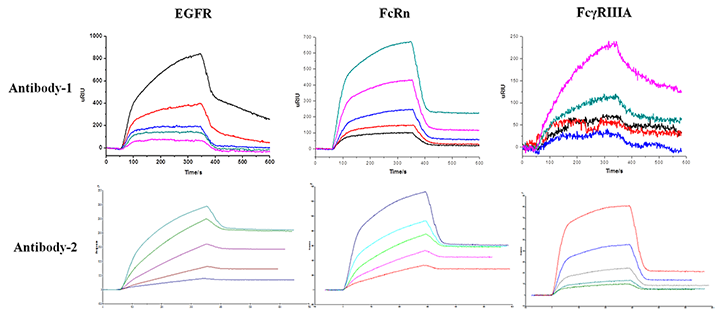Protein-protein interactions (PPIs) are highly specific physical contacts established between two or more protein molecules, which are the result of biochemical events caused by electrostatic forces. It is critical to understand how they interact at residual levels during the early stage and later stage of drug development. Surface Plasmon Resonance imaging (SPRi), namely Surface Plasmon Resonance Microscopy (SPRM), is a high-sensitive, real-time, label-free, and high-throughput technique which is used to study biomolecular interactions based on detecting the refractive index changes resulting from molecular binding. Moreover, protein-protein interactions play an important role in transcription and other biological processes.
Service Content: The affinities of candidate drug Antibody-1 and candidate drug Antibody-2 for EGFR, FcRn, FcγRIIIA were determined.
Methods: Multi-concentration gradient fitting, multiple 3-fold SD screening
Results: The reliable affinity constants were obtained for later biological experiments and clinical trials. The Application of SPRi technology significantly reduces the time and cost in protein-protein interaction assay.

In conclusion, SPRi is a well-established leading technology for measuring binding association (ka) and dissociation rates (kd), affinities (KD) for protein-protein interactions.
Creative Peptides offers SPRi (Surface Plasmon Resonance imaging) services including Biochip design and printing, Bio-interactions analysis (binding affinity and kinetic processes detection), Summary and analysis of the results. The SPRi technology also shows great promise to study even more complex protein-protein interactions. We can follow the customer's request for high-precision analysis of protein-protein interactions while ensuring reasonable price and accurate analytical data.
References